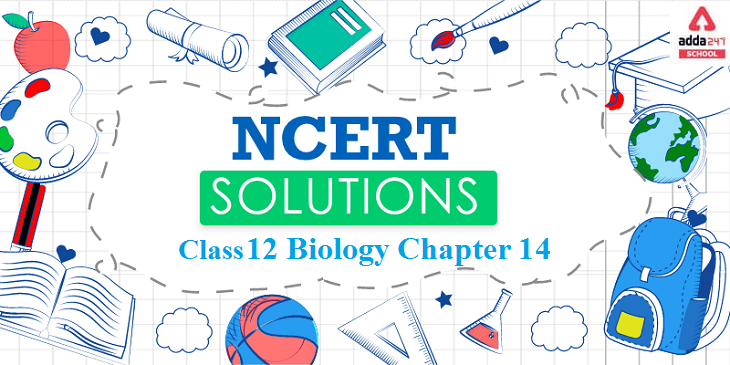NCERT Solutions for Class 12 Biology Chapter 14 Pdf Download
Adda 247 provides NCERT Solutions for Class 12 Biology chapter 14 NCERT solutions which is for the students who want to go ahead in life and achieve great marks in their examinations. The NCERT Solutions for class 12 are provided by the teachers who are experts of their subjects. The solutions are set according to the rules formulated by the NCERT class 12 biology and in the language that can be understood by every student. By these reading the solutions students can build up a strong base easily. The NCERT class 12 Biology solutions covers the chapters 1 to 16 with the important questions and the answers in a detailed way.
Examinations can be threatening for some people, a proper learning of the concepts is the key to crack the examination. Students rely on the solutions of the NCERT provided by Adda 247. The solutions are formulated by the experts of the subjects who have tremendous knowledge in their subjects.
These NCERT Solutions of class 12 chapter 14 help the students to get familiarized with the textbooks. The students can access the solutions anywhere while browsing the web easily. The solutions are very precise and accurate.
NCERT Solutions for Class 12 Biology Chapter 14– Ecosystem
The chapter provides information about Ecosystem. An ecosystem can be defined as a functional unit of nature, where living organisms interact among themselves and also with the surrounding physical environment. An ecosystem is divided into two basic categories: Terrestrial ecosystem. Example- forest, desert. Aquatic ecosystem. Example- pond, lake, wetland. The various components of the environment are abiotic and biotic. Interaction of biotic and abiotic components result in a physical structure that is characteristic for each type of ecosystem. Biotic components are the living beings and abiotic components are the non-living things of the ecosystem.
Features of the NCERT Solutions Class 12 Biology Chapter 14– Ecosystem
NCERT Solutions for class 12 biology chapter 14 have been answered based on the important information on the question.
- The columns are used wherever necessary.
- Solutions are solved point wise and accurately answered point to point.
Important Question of Ncert Solutions for Class 12 Chapter 14: Ecosystem
Question 1. Fill in the blanks.
(a) Plants are called as_________ because they fix carbon dioxide.
(b) In an ecosystem dominated by trees, the pyramid (of numbers) is_________ type.
(c) In aquatic ecosystems, the limiting factor for the productivity is_________.
(d) Common detritivores in our ecosystem are_________.
(e) The major reservoir of carbon on earth is_________.
Answer:
(a) Plants are called as Autotrophs because they fix carbon dioxide and produces their own food.
(b) In an ecosystem dominated by trees, the pyramid (of numbers) is of Inverted type because it makes more biomass that leads to the large population of birds and insects as compared to the trees.
(c) In aquatic ecosystems, the limiting factor for productivity is light as plants and algae cannot grow in the absence of light.
(d) Common detritivores in our ecosystem are earthworms as they get nutrients from decaying organic matter.
(e) A major reservoir of carbon on earth is oceans.
Question 2. Which one of the following has the largest population in a food chain?
(a) Producers
(b) Primary consumers
(c) Secondary consumers
(d) Decomposers
Answer: (d) Decomposers
Decomposers include micro-organisms such as bacteria and fungi. They form the largest population in a food chain and obtain nutrients by breaking down the remains of dead plants and animals.
Question 3. The second trophic level in a lake is
(a) Phytoplankton
(b) Zooplankton
(c) Benthos
(d) Fishes
Answer: (b) Zooplankton Zooplankton are primary consumers in aquatic food chains that feed upon phytoplankton. Therefore, they are present at the second trophic level in a lake.
Question 4. Secondary producers are
(a) Herbivores
(b) Producers
(c) Carnivores
(d) None of the above
Answer: (d) None of the above Plants are the only producers. Thus, they are called primary producers. There are no other producers in a food chain.
Question 5. What is the percentage of photosynthetically active radiation (PAR) in the incident solar radiation?
(a) 100%
(b) 50 %
(c) 1-5%
(d) 2-10%
Answer: (b) 50%
Out of total incident solar radiation, about fifty percent of it forms photosynthetically active radiation or PAR.
Question 6. Distinguish between
(a) Grazing food chain and detritus food chain
(b) Production and decomposition
(c) Upright and inverted pyramid
(d) Food chain and Food web
(e) Litter and detritus
(f) Primary and secondary productivity
Answer:
(a) Grazing food chain and detritus food chain
| Grazing food chain | Detritus food chain |
| In this food chain, energy is derived from the Sun. | In this food chain, energy comes from organic matter (or detritus) generated in trophic levels of the grazing food chain. |
| It begins with producers, present at the first trophic level. The plant biomass is then eaten by herbivores, which in turn are consumed by a variety of carnivores. | It begins with detritus such as dead bodies of animals or fallen leaves, which are then eaten by decomposers or detritivores. These detritivores are in turn consumed by their predators. |
| This food chain is usually large. | It is usually smaller as compared to the grazing food chain. |
(b) Production and decomposition
| Production | Decomposition |
| It is the rate of producing organic matter (food) by producers. | It is the process of breaking down of complex organic matter or biomass from the body of dead plants and animals with the help of decomposers into organic raw material such as CO2, H2O, and other nutrients. |
| It depends on the photosynthetic capacity of the producers. | It occurs with the help of decomposers. |
| Sunlight is required by plants for primary production. | Sunlight is not required for decomposition by decomposers |
(c) Upright and inverted pyramid
| Upright pyramid | Inverted pyramid |
| The pyramid of energy is always upright. | The pyramid of biomass and the pyramid of numbers can be inverted. |
| In the upright pyramid, the number and biomass of organisms in the producer level of an ecosystem is the highest, which keeps on decreasing at each trophic level in a food chain. | In an inverted pyramid, the number and biomass of organisms in the producer level of an ecosystem is the lowest, which keeps on increasing at each tropic level. |
(d) Food chain and Food web
| Food chain | Food web |
| It is a single linear sequence of organisms. | It contains a number of interconnected food chains. |
| Members present at higher trophic levels feed on single types of organisms. | One organism has alternate food sources. |
(e) Litter and detritus
| Litter | Detritus |
| Litter contains all kinds of wastes generated above the ground. | Detritus is composed of the remains of dead plants and animals. |
| Litter contains both biodegradable and non-biodegradable matter. | Detritus contains only biodegradable matter. |
(f) Primary and secondary productivity
| Primary productivity | Secondary productivity |
| It is defined as the amount of organic matter produced by producers per unit area over a period of time. | It is defined as the rate of production of organic matter by consumers over a period of time. |
Question 7. Describe the components of an ecosystem.
Answer: An ecosystem refers to be the functional unit of nature in which living organisms interact among themselves and also with their surrounding physical environment in order to perform nutrient cycling, energy flow, decomposition and productivity. There are many types of ecosystems such as pond ecosystem, forest ecosystem etc.
Components of ecosystem
The components of the ecosystem can be divided into abiotic components and biotic components
- Abiotic components- These include the non-living components of nature such as light, temperature, water, soil, air, inorganic nutrients etc.
- Biotic components- The biotic components of an ecosystem refer to the living organisms present in that ecosystem. The biotic components are divided as producers, consumers and decomposers. Producers are plants, consumers include animals which can be herbivores or carnivores and decomposers include microorganisms like fungi and bacteria.
Question 8. Define ecological pyramids and describe with examples, pyramids of number and biomass.
Answer: Ecological pyramids They are the graphical representations of various ecological parameter at the successive trophic levels of food chains with producers at the base top carnivores at the apex and intermediate levels .in between. Quantity at each level is indicated by length of bar in the graph. The pyramids are therefore also called bar diagrams. Pyramids of number It is graphical representation of numerical strength of various populations in different trophic levels per unit area of an ecosystem with producers forming base intermediate levels forming intermediate tiers and apex formed by top carnivores length of bar at each trophic level is proportional to the number of individuals at this level.
Pyramid of biomass : Biomass is the amount of living matter measured in terms of fresh or dry weight. Dry weight is preferred as it avoids seasonal variations in moisture content of biomass. Pyramid of biomass is the graphical representation of amount of biomass per unit area sequence wise in rising trophic levels with producers at the base and top carnivores at the apex. Length of the bar indicates the comparative amount of biomass at that trophic level. Biomass, is maximum in producers. Only 10% to 20% biomass is passed from producer level to herbivore level.
Question 9. What is primary productivity? Give brief description of factors that affect primary productivity.
Answer: It is defined as the amount of organic matter or biomass produced by producers per unit area over a period of time.
Primary productivity of an ecosystem depends on the variety of environmental factors such as light, temperature, water, precipitation, etc. It also depends on the availability of nutrients and the availability of plants to carry out photosynthesis.
Question 10. Define decomposition and describe the processes and products of decomposition.
Answer: Decomposition is the process of breaking down of complex organic matter with the help of decomposers into smaller inorganic raw material such as CO2, H2O, and other nutrients. It constitutes of various processes:
- Fragmentation: The breakdown of detritus (Organic matter) into smaller pieces by the action of detritivores (earthworms).
- Leaching: The water-soluble nutrients move down into the layers of soil and get locked as unavailable salts.
- Catabolism: Further the detritus is degraded into smaller pieces by bacteria and fungi through various enzymes.
- Humification: Humification leads to the formation of a dark coloured colloidal substance called humus, which acts as reservoir of nutrients for plants.
- Mineralization: The process of releasing inorganic nutrients from the humus in the soil is done by microbes and this process is known as mineralization
Decomposition thus leads to the production of a dark coloured, nutrient-rich substance called humus. Degradation of humus releases inorganic raw materials such as CO2,water, and other nutrient in the soil.
Frequently Asked Questions on NCERT Solutions for Class 12 Biology Chapter 14
What are the advantages of referring NCERT Solutions for class 12 Biology chapter 14?
Students referring the ncert solutions for class 12 biology chapter 14 pdf download by Adda 247 find the solutions helpful during the exams. The solutions are prepared by the experts in an interactive manner keeping in mind the students. The students’ perspective is kept in mind while preparing the solutions. It helps in completing the syllabus on time and also provides notes for the revision prior to the exam.
What are the advantages of referring NCERT in competitive exams like JEE and AIPMT?
Most of the competitive exams like NEET, JEE etc. follow the basic NCERT books for designing their question papers. NCERT serves as the base for every book prepared for NEET and JEE. The competitive exams are based on the CBSE syllabus applied in XI and XII classes and NCERT books strictly follow CBSE syllabus. In addition to this, NCERT books play an important role in clearing out the theoretical concepts. Every topic given in NCERT books is explained in such a way to help students make their basics and fundamentals strong and clear.
How To Use NCERT Solutions For Class 14 Biology?
- i) Study the chapter topic wise and understand the various concepts.
- ii) First, try to solve the questions by yourself and then look at the solutions.
- iii) Use them as a reference guide while revising the chapter.
- iv) If you get stuck at any question, you can check the step by step solution from the PDF from ncert solutions for class 12 biology chapter 13 pdf download by Adda 247.
Is it mandatory to solve all the NCERT questions mentioned at the end of each chapter?
The questions and answers mentioned in NCERT textbooks at the end of each chapter are quite important not only for examination but also for understanding the concepts in a better way. These questions aim to test the students’ understanding and learning over the topics that they have learned in the chapter.
Solving the NCERT exercise problems will help to
- clear all the concepts and formulae you learned in a chapter
- get comfortable with different types of questions that might be asked in exams
- get enough practice which is key to succeed in Mathematics exam
- improve your accuracy and speed
What are the important concepts covered in the Chapter 14 of NCERT Solutions for Class 12 Biology?
The concepts involved in the chapter 14 of NCERT Solutions are –
14.1 – Ecosystem–Structure and Function
- 2 – Productivity
14.3 – Decomposition
14.4 – Energy Flow
14.5 – Ecological Pyramids
14.6 – Ecological Succession
14.7 – Nutrient Cycling
14.8 – Ecosystem Services
These concepts are created by the faculty at Adda 247. The solutions are available at Adda 247 in the PDF format which can be downloaded by the students.
| NCERT Solutions for Class 12 Biology Chapter-wise |
|
Chapter 1: Sexual Reproduction in Flowering Plants
|
|
Chapter 2: Human Reproduction
|
|
Chapter 3: Reproductive Health
|
|
Chapter 4: Principles of Inheritance and Variation
|
|
Chapter 5: Molecular Basis of Inheritance
|
|
Chapter 6: Evolution
|
|
Chapter 7: Human Health and Disease
|
|
Chapter 8: Microbes in Human Welfare
|
|
Chapter 9 : Biotechnology: Principles and Processes
|
|
Chapter 10: Biotechnology and its Applications
|
|
Chapter 11: Organisms and Populations
|
|
Chapter 12: Ecosystem
|
|
Chapter 13: Biodiversity and Conservation
|











 CBSE Admit Card 2026 for Private & R...
CBSE Admit Card 2026 for Private & R...
 AILET 2026 AIR 1: Check Full Toppers Lis...
AILET 2026 AIR 1: Check Full Toppers Lis...
 AILET Result 2026 OUT, How to Download S...
AILET Result 2026 OUT, How to Download S...






